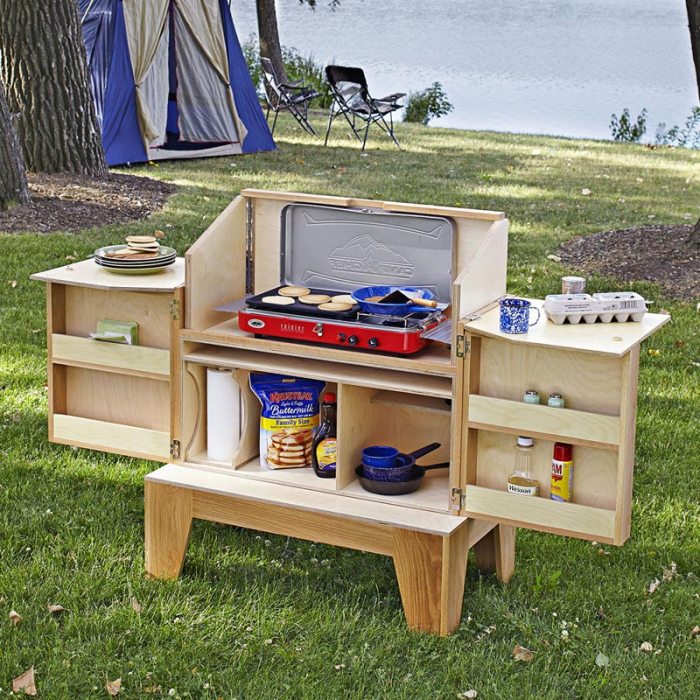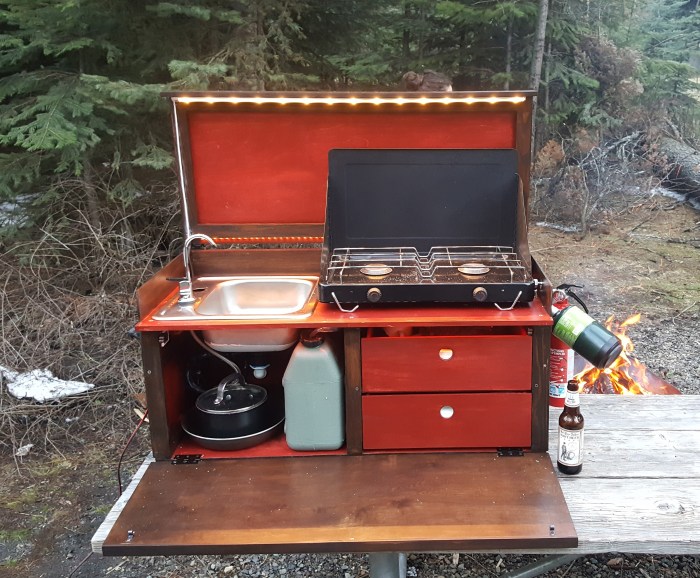DIY camp kitchen sets the stage for a captivating exploration of building your own portable outdoor cooking haven. Whether you’re a seasoned camper or a novice adventurer, crafting a personalized camp kitchen offers numerous advantages. You gain control over the design, materials, and features, ensuring your kitchen perfectly complements your camping style and needs.
From the essential components like a sturdy countertop and ample storage to innovative design ideas and essential accessories, this guide delves into the world of DIY camp kitchens. We’ll cover everything from basic construction techniques to tips for cooking delicious meals in the great outdoors, empowering you to create a functional and stylish kitchen that enhances your camping experience.
The Allure of DIY Camp Kitchens

The allure of a DIY camp kitchen lies in its ability to transform your camping experience, turning a simple outdoor meal into a culinary adventure. Crafting your own camp kitchen offers a unique blend of practicality, personalization, and cost-effectiveness, allowing you to design a space that perfectly complements your camping style.
Benefits of Building a DIY Camp Kitchen
Building your own camp kitchen provides several advantages over commercially available options. It allows you to tailor the design to your specific needs, ensuring optimal functionality and portability. You can choose the materials, size, and features that best suit your camping style, from a compact setup for solo trips to a spacious kitchen for family adventures. Additionally, building your own camp kitchen can be significantly more cost-effective than purchasing a pre-made one, especially if you utilize repurposed materials or have basic woodworking skills.
Real-Life Stories of Successful DIY Camp Kitchens
Many campers have successfully built their own kitchens, transforming their camping experiences. One such example is John, who crafted a portable kitchen from reclaimed wood and salvaged metal. His creation features a compact countertop, storage compartments, and a built-in stovetop, allowing him to prepare elaborate meals while enjoying the convenience of a fully functional kitchen in the wilderness. Another inspiring example is Sarah, who created a stylish and functional camp kitchen using reclaimed pallets and upcycled materials. Her kitchen boasts a unique rustic aesthetic, providing ample storage space and a dedicated area for food preparation. These stories highlight the creativity and practicality of DIY camp kitchens, showcasing how they can elevate the camping experience.
Comparison of DIY and Commercial Camp Kitchens
While commercially available camp kitchens offer convenience and pre-built designs, DIY options provide a level of customization and cost-effectiveness that is difficult to match. Here’s a comparison of their features and advantages:
| Feature | DIY Camp Kitchen | Commercial Camp Kitchen |
|---|---|---|
| Customization | Highly customizable | Limited customization options |
| Portability | Can be designed for optimal portability | Often pre-designed for specific portability levels |
| Cost-effectiveness | Can be significantly more cost-effective | Can be expensive, especially for high-end models |
| Durability | Durability depends on material choices and construction | Generally built for durability |
| Aesthetics | Can be designed to match your personal style | Often have a pre-determined aesthetic |
DIY camp kitchens offer a unique blend of practicality, personalization, and cost-effectiveness, making them an appealing choice for campers seeking a tailored and functional outdoor cooking experience.
Essential Components of a DIY Camp Kitchen

A well-designed camp kitchen is a cornerstone of any successful camping trip, providing a comfortable and functional space for preparing meals and enjoying the outdoors. The key to building a DIY camp kitchen lies in choosing the right components and ensuring they work together harmoniously. This section will delve into the essential elements of a DIY camp kitchen, outlining a basic layout, suitable materials, and necessary tools.
Basic Layout Design
A basic layout for a DIY camp kitchen typically includes three primary zones: a cooking surface, storage space, and a work area. These zones should be arranged in a logical and efficient manner to facilitate easy movement and prevent clutter.
- Cooking Surface: The cooking surface is the heart of any camp kitchen. It should be positioned centrally, allowing for easy access from all sides. Consider using a portable camp stove, a fire pit, or a built-in grill for this purpose.
- Storage Space: Adequate storage is crucial for keeping supplies organized and accessible. Shelves, cabinets, and drawers can be incorporated to store cookware, utensils, food, and other camping essentials.
- Work Area: A designated work area provides a dedicated space for preparing food, cleaning dishes, and general meal prep. This area can be a simple countertop, a folding table, or a custom-built work surface.
Materials for Building a DIY Camp Kitchen
The choice of materials for your DIY camp kitchen is influenced by factors like durability, weight, and weather resistance. Here are some commonly used materials:
- Wood: Wood is a readily available and versatile material. For camp kitchens, treated lumber or weather-resistant woods like cedar or redwood are ideal. However, wood requires regular maintenance to prevent rot and insect damage.
- Metal: Metal offers superior durability and weather resistance compared to wood. Aluminum, steel, and stainless steel are common choices. Metal can be heavy, but its strength and longevity make it a viable option for a long-lasting camp kitchen.
- Plastic: Plastic is lightweight, affordable, and often water-resistant. However, it may not be as durable as wood or metal and can degrade over time. Plastic is a good choice for smaller components or temporary camp kitchens.
Essential Tools and Equipment
Constructing a DIY camp kitchen requires a few essential tools and equipment. The specific tools will vary depending on the complexity of your design, but here’s a basic list:
- Measuring Tape: Essential for accurate measurements during planning and construction.
- Level: Ensures that your kitchen surfaces are even and stable.
- Saw: A handsaw, circular saw, or jigsaw is needed for cutting materials to size.
- Drill: A cordless drill with various drill bits is helpful for drilling holes and securing components.
- Screwdriver: A set of screwdrivers with various sizes is necessary for assembling the kitchen.
- Clamps: Clamps are useful for holding materials in place while securing them with screws or nails.
- Safety Gear: Safety goggles, gloves, and a dust mask are crucial for protecting yourself from hazards during construction.
Building a DIY Camp Kitchen

Building a DIY camp kitchen is a rewarding project that allows you to create a custom space for cooking and dining in the great outdoors. It involves choosing the right materials, constructing a sturdy frame, and incorporating essential features like a countertop, storage compartments, and a sink. By following this step-by-step guide, you can build a functional and aesthetically pleasing camp kitchen that enhances your camping experience.
Choosing the Right Materials
Selecting the right materials is crucial for building a durable and functional camp kitchen. The materials you choose should be weather-resistant, lightweight, and easy to assemble.
- Wood: Pressure-treated lumber is ideal for the frame and countertop as it resists rot and moisture. Consider using cedar or redwood for their natural insect-repellent properties.
- Metal: Aluminum or galvanized steel can be used for the frame, countertop, and storage compartments. They are lightweight and durable, but may require more intricate assembly.
- Plywood: Marine-grade plywood is an excellent option for the countertop as it is water-resistant and can be easily cut and shaped.
- Hardware: Use stainless steel screws, hinges, and other hardware to ensure longevity and resist rust.
Assembling the Frame, Diy camp kitchen
The frame provides the structural support for your camp kitchen. You can choose from different designs based on your needs and preferences.
- Simple Frame: A basic frame can be constructed using four upright posts connected by horizontal beams. This design is easy to assemble and provides a sturdy foundation.
- L-Shaped Frame: An L-shaped frame creates a more spacious kitchen area with a countertop and additional storage space. This design is ideal for larger groups or those who need more working space.
- Modular Frame: A modular frame consists of separate sections that can be easily assembled and disassembled. This design is convenient for transportation and storage.
Use a level to ensure the frame is square and plumb before attaching the countertop. Consider using pre-drilled holes for easier assembly and to prevent splitting the wood.
Attaching the Countertop
The countertop is the heart of your camp kitchen, providing a surface for cooking, prepping food, and dining.
- Secure Attachment: Use heavy-duty screws or brackets to securely attach the countertop to the frame. Ensure the countertop is level and flush with the frame.
- Cutouts: Consider cutting out sections of the countertop for a built-in sink, cutting board, or spice rack.
- Finishing: Apply a sealant or stain to the countertop to protect it from the elements and enhance its durability.
Adding Storage Compartments
Storage compartments are essential for keeping your camp kitchen organized and efficient.
- Shelves: Install shelves beneath the countertop to store pots, pans, and other cooking supplies.
- Cabinets: Build cabinets with doors to store more sensitive items like food or utensils.
- Drawers: Add drawers for easy access to smaller items.
Incorporating Features
Adding features like a built-in sink, a spice rack, and a cutting board enhances the functionality of your camp kitchen.
- Built-in Sink: Install a small, portable sink in a cutout in the countertop. Use a sealant to ensure a watertight seal.
- Spice Rack: Build a simple spice rack using wood or metal and attach it to the underside of the countertop.
- Cutting Board: Create a cutting board by using a piece of marine-grade plywood or cutting board material and attaching it to the countertop with hinges.
Building a DIY camp kitchen is a rewarding endeavor that blends practicality with creativity. You’ll not only enjoy the satisfaction of crafting a custom-made cooking space, but also reap the benefits of a portable, efficient, and personalized kitchen that elevates your camping adventures. With a little planning, ingenuity, and this guide as your compass, you’ll be well on your way to creating a DIY camp kitchen that perfectly complements your outdoor lifestyle.
Building a DIY camp kitchen is a great way to personalize your outdoor experience. However, it’s important to consider the materials you use, as some may contain chemicals like fluoroquinolones which could be harmful if ingested. Always choose materials that are safe for food preparation and ensure proper hygiene practices to avoid any potential risks.
